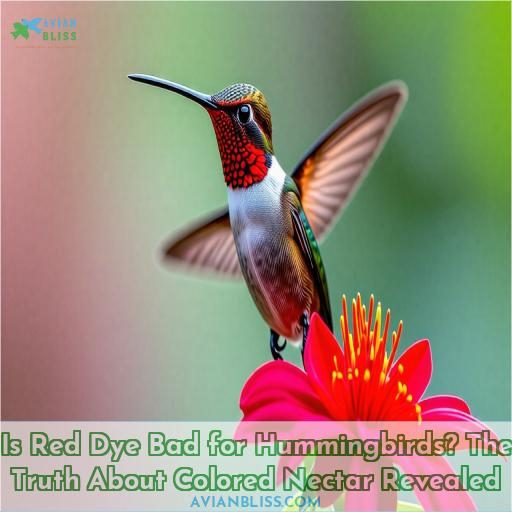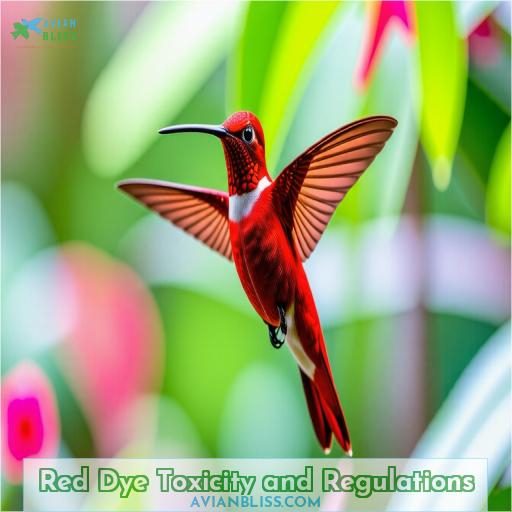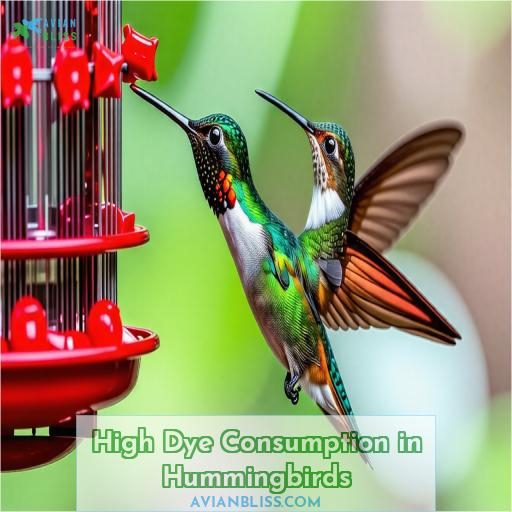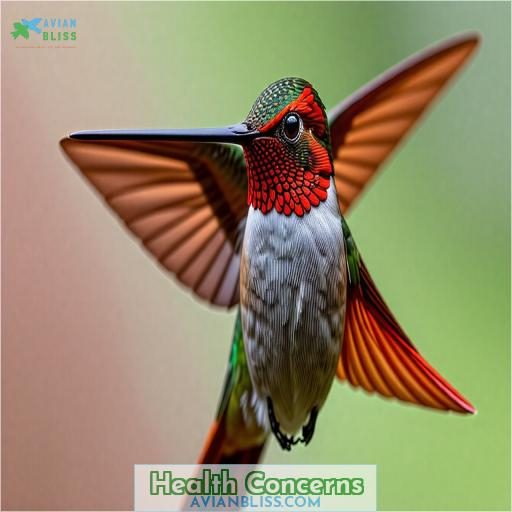This site is supported by our readers. We may earn a commission, at no cost to you, if you purchase through links.
 You should avoid feeding hummingbirds with red dye nectar. While the bright color may seem attractive, the synthetic dyes are potential toxins that could harm these tiny birds.
You should avoid feeding hummingbirds with red dye nectar. While the bright color may seem attractive, the synthetic dyes are potential toxins that could harm these tiny birds.
Hummingbirds consume an astonishing amount of nectar daily, ingesting up to 17 times the maximum human dose of red dye. With dye amounts unregulated, they face risks of bioaccumulation and related health issues.
Experts, like Cornell’s Lab of Ornithology, strongly discourage using red dye nectar.
Instead, opt for a simple 4:1 sugar-water solution in clear feeders – it’s inexpensive and just as enticing.
To grasp the full picture, let’s explore the concerns in more detail.
Table Of Contents
- Key Takeaways
- Is Red Dye Bad for Hummingbirds?
- Red Dye Toxicity and Regulations
- High Dye Consumption in Hummingbirds
- Natural Nectar Substitute
- Red Dye in Commercial Nectars
- Health Concerns
- Frequently Asked Questions (FAQs)
- Is it okay to add red food coloring to hummingbird food?
- How can I attract hummingbirds without red dye?
- What is toxic to hummingbirds?
- Do hummingbirds like the color red?
- How can I tell if my hummingbird feeder has red dye?
- What are the symptoms of red dye poisoning in hummingbirds?
- Are there any safe alternatives to red dye for hummingbird feeders?
- How can I encourage hummingbirds to visit my feeder without using red dye?
- What should I do if I suspect my hummingbirds have been exposed to red dye?
- Conclusion
Key Takeaways
- Red dye used in commercial hummingbird nectar is banned in multiple European countries due to potential health concerns, despite FDA approval in the U.S.
- Hummingbirds consume up to 17 times the maximum recommended human dose of red dye, raising serious long-term health implications like bioaccumulation and toxicity.
- Experts strongly discourage the use of red dye in hummingbird food, recommending a simple homemade sugar-water solution as a safer, cost-effective alternative.
- The lack of scientific studies on the specific effects of red dye on hummingbirds highlights the need for further research to fully understand the risks posed to these delicate birds.
Is Red Dye Bad for Hummingbirds?
No, there’s no conclusive evidence that red dye is definitively bad for hummingbirds. However, experts recommend avoiding red dye in hummingbird nectar due to the lack of scientific studies on its long-term effects and the potential for hummingbirds to consume unsafe amounts of the dye.
Red Dye Toxicity and Regulations
You may be surprised to learn that the red dye commonly used in hummingbird nectar is banned in multiple European countries due to potential health risks.
Despite its chemical name, 2-naphthalenesulfonic acid, 6-hydroxy-5-((2-methoxy-5-methyl-4-sulfophenyl)azo)-, disodium salt, there’s a concerning lack of scientific studies investigating its specific effects on hummingbirds.
This prompts experts like the Cornell Lab of Ornithology to strongly recommend against its use.
Banned in Multiple Countries
Red dye is banned in Austria, Belgium, Denmark, France, Germany, Sweden, and Switzerland due to health concerns (Source). It contains 2-naphthalenesulfonic acid, 6-hydroxy-5-((2-methoxy-5-methyl-4-sulfophenyl)azo)-, disodium salt. There are no scientific studies on health effects specifically on hummingbirds .
Chemical Composition
The chemical name of red dye is 2-naphthalenesulfonic acid, 6-hydroxy-5-((2-methoxy-5-methyl-4-sulfophenyl)azo)-, disodium salt. This petroleum-based dye is a common additive in commercial hummingbird nectar, despite concerns about its potential toxicity.
Lack of Scientific Studies on Hummingbirds
Despite the lack of scientific studies on hummingbirds, anecdotal evidence and European bans on red dye suggest potential health risks. More research is needed to fully understand its effects on these tiny birds.
Expert Recommendations
The Cornell Lab of Ornithology strongly discourages using red dye in hummingbird food. Instead, they recommend:
- Providing homemade nectar without dyes.
- Choosing feeders with red accents.
- Maintaining a balanced hummingbird diet.
High Dye Consumption in Hummingbirds
You should be aware that hummingbirds consume a staggering amount of nectar daily, ingesting up to 17 times the maximum recommended dose of red dye for humans. With unregulated dye quantities in commercial nectars exposing birds to potentially harmful levels, it’s wise to contemplate a cost-effective, homemade alternative.
Daily Nectar Intake
When considering hummingbirds’ daily nectar intake, their consumption often far exceeds human limits with colored nectar containing dyes vs. natural options, leading to potential health effects like dye adherence and urine color variations.
- Consumption may surpass human daily maximum intake.
- Dyes in nectar can lead to potential health effects.
- Color discrepancies between consumed dyes and hummingbirds’ urine.
Exceeding Human Limits
Hummingbirds consume 17 times the maximum daily dye limit for humans, far exceeding safe levels. This high dye metabolism raises serious long-term health implications.
- Dye bioavailability and accumulation
- Potential carcinogenic and mutagenic effects
- Disruption of reproductive and developmental processes
- Neurological and behavioral abnormalities
- Alternative sweeteners like fruit juices are safer
Unregulated Dye Amounts
The amount of red dye in commercial hummingbird nectars is unregulated, allowing birds to consume 17 times the maximum daily limit recommended for humans.
- Hummingbirds ingest high concentrations of dye from nectar, far exceeding levels known to cause harm in other animals.
- The dye can accumulate in a hummingbird’s body, potentially leading to toxic effects over time.
- Without regulation, manufacturers can add any amount of dye to their products, putting hummingbirds at risk.
Potential Health Risks
Hummingbirds may ingest dangerously high levels of red dye, which can accumulate in their bodies and potentially cause tumors, reduced reproduction, and other health issues.
- Ingestion: Hummingbirds consume up to 17 times the recommended human limit of red dye when drinking colored nectar.
- Metabolism: The dye can be absorbed and chemically altered, potentially causing DNA damage in the gut.
- Excretion: Hummingbird urine is paler than the dyed nectar, indicating the dye isn’t fully excreted.
- Toxicology: Red dye has been linked to tumors, reduced brain weight, and behavioral abnormalities in animal studies, raising concerns for hummingbirds.
Cost-effective Alternative
Homemade nectar is a cost-effective alternative to store-bought dyed solutions. Use a 4:1 water-to-sugar ratio and clear feeders – no need for artificial colorants.
- Homemade nectar is notably cheaper than commercial options.
- Clear feeders with natural colorants attract hummingbirds just as well.
- Avoid unnecessary sugar water dyes that may harm these delicate birds.
Natural Nectar Substitute
You don’t need to add red dyes to your hummingbird nectar solution. A simple homemade nectar made with a 4:1 ratio of water to white sugar mimics the natural nectar found in flowers and provides all the nutrition hummingbirds need.
Homemade Nectar Recipe
To make a simple, natural hummingbird nectar, combine 1 part sugar with 4 parts water. Boil the mixture until the sugar dissolves, then let it cool before filling your feeders. Change the nectar every 2-3 days for best results.
- Use a 4:1 water to sugar ratio for a natural nectar substitute.
- Boil the solution to fully dissolve the sugar before cooling and filling feeders.
- Regularly change the nectar every 2-3 days to keep it fresh.
- Homemade nectar is a cost-effective and safe alternative to commercial dyed options.
No Benefits of Dyes
When feeding hummingbirds, avoiding dyes in nectar is essential as they offer no benefits and pose risks like unnecessary expense, potential damage, and ingestion risks. Opt for natural alternatives like plain sugar solutions for cost-effective and safe feeding.
- No benefits of dyes
- Unnecessary expense
- Waste of money
- Potential damage
- Ingestion risks
Feeder Attractants
To attract hummingbirds, consider planting nectar-rich flowers like standing cypress and mints, common in Texas hummingbirds habitats. Strategically place feeders in sunny areas to attract hummingbirds. Keep nectar fresh by changing it every 2-3 days and maintain feeder hygiene. Provide natural water sources and avoid pesticides to support a balanced hummingbird diet.
Suitable Sweeteners
Homemade nectar using plain white sugar is the safest, most cost-effective option for hummingbirds. Avoid artificial dyes and sweeteners, which may be harmful. Feeder design is key for attracting birds without colored nectar.
Red Dye in Commercial Nectars
You’re likely familiar with commercial hummingbird nectars, often vibrant red due to the inclusion of petroleum-based food dyes like Red Dye 40.
Despite being approved by the FDA in the U.S., this artificial coloring raises safety concerns.
It’s banned in multiple European countries due to potential health risks.
No scientific studies have evaluated its effects specifically on hummingbirds, which ingest dye at levels far exceeding the human limit.
Petroleum-based Dye
Commercial hummingbird nectars contain petroleum-based Red Dye 40, an environmental pollutant that can bioaccumulate in birds over time, with unknown long-term effects. Natural colorants are a safer alternative.
- Red Dye 40 is a synthetic, petroleum-derived colorant used in many commercial hummingbird nectar products.
- This dye has been linked to environmental contamination and potential bioaccumulation in birds over time.
- The long-term health effects of Red Dye 40 on hummingbirds are unknown, as no thorough studies have been conducted.
- Natural plant-based colorants offer a safer, more environmentally-friendly alternative to synthetic dyes in hummingbird feeders.
FDA Approval and Safety Concerns
Red Dye 40 is FDA-approved in the US despite safety concerns and is banned in multiple European countries. Studies on its impact on hummingbirds are lacking. Experts discourage its use .
- Lack of scientific studies on hummingbirds
- FDA approval despite safety concerns
- Banned in multiple European countries
- Expert discouragement of its use
International Bans
Several European countries have banned the use of red dye in consumer products due to health concerns, despite FDA approval in the United States.
- Austria, Belgium, Denmark, France, Germany, Sweden, and Switzerland have prohibited the use of red dye in food and consumer goods.
- These bans reflect ongoing safety debates around the potential health risks of red dye, which remain unresolved.
- The discrepancy between international bans and FDA approval highlights the need for further research on the impacts of red dye, especially on vulnerable species like hummingbirds.
Lack of Hummingbird Studies
Despite the lack of scientific studies on red dye’s effects on hummingbirds, anecdotal evidence suggests potential health risks, highlighting the need for further research to fill this knowledge gap.
- Hummingbirds consume 17 times the maximum daily limit of red dye recommended for humans.
- No research proves red dye is safe for hummingbirds.
- Anecdotal evidence links red dye to tumors and higher mortality rates in hummingbirds.
- More studies are needed to determine the long-term effects of red dye on hummingbird health and survival.
Expert Discouragement
Experts discourage the use of commercial nectars with red dye due to potential health risks for hummingbirds, as historical practices are being re-evaluated. Consider alternative colorants and prioritize nectar consumption patterns. Maintain bird feeder hygiene and acknowledge the natural diet composition. (Source)
Health Concerns
There is anecdotal evidence suggesting that feeding hummingbirds nectar containing red dye leads to higher mortality rates and increased incidence of tumors. Given the lack of scientific research specifically examining the health effects of these dyes on hummingbirds, the Cornell Lab of Ornithology strongly recommends against using colored nectar solutions.
Tumors and Mortality
Hummingbirds fed dyed nectar may suffer higher tumor prevalence, mortality rates, and reduced lifespan. Anecdotal reports link red dye to liver damage and bill deformities. These alarming health concerns underscore the need for further research into the safety of artificial colorants for these delicate birds.
Lack of Safety Research
Despite the concerning evidence, no scientific studies have conclusively proven the long-term effects of red dye on hummingbirds. The lack of regulation and anecdotal observations suggest potential risks, but hummingbird physiology and environmental impact require further investigation.
- Lack of regulation on dye amounts in commercial nectars
- Anecdotal observations of higher mortality and tumors
- Potential long-term effects on hummingbird health and environment
Cornell Lab Recommendation
To address health concerns, the Cornell Lab advises using only clear nectar for hummingbirds, recommending against red dye due to potential risks (Source). This guidance emphasizes the importance of avoiding colored solutions to safeguard bird health, aligning with the lab’s commitment to hummingbird well-being.
Frequently Asked Questions (FAQs)
Is it okay to add red food coloring to hummingbird food?
You love watching those tiny hummers at your feeder, don’t you? Well, adding that red food coloring could make them sick. Stick to plain sugar water – their bright feathers get the message across just fine.
How can I attract hummingbirds without red dye?
You can attract hummingbirds with brightly colored feeders or flowers. Place feeders near plants and change the nectar every few days with a homemade sugar-water solution – no dye needed!
What is toxic to hummingbirds?
Avast, ye scurvy dogs! Here be what’s toxic to our feathered friends, the hummingbirds: pesticides, heavy metals, and artificial sweeteners. Steer clear of these noxious substances if ye value their dazzling company. Now, quit yer gawkin’ and heed this wisdom!
Do hummingbirds like the color red?
Yes, hummingbirds are naturally attracted to the color red. Red flowers signal a rich nectar source, so red feeders effectively lure these tiny birds. However, you don’t need food dyes—the feeder’s vibrant shade alone is enticing enough.
How can I tell if my hummingbird feeder has red dye?
Check the ingredient list – if it lists red dyes like Red 40 or carmine, that’s a sign. As hummers gulp down more nectar than tiny bodies can handle, dyes could harm them over time.
What are the symptoms of red dye poisoning in hummingbirds?
Lethargy, feather discoloration, tumors, difficulty breathing, and premature death may indicate red dye poisoning in hummingbirds.
Are there any safe alternatives to red dye for hummingbird feeders?
Yes, you can safely use fruit or vegetable extracts like cherry juice concentrate to color homemade nectar red instead of artificial dyes.
How can I encourage hummingbirds to visit my feeder without using red dye?
Embrace nature’s allure–a vibrant red feeder or adornments beckon hummingbirds without dye. Their innate curiosity craves movement and color, not artificial substitutes. Let their wonder unfold organically.
What should I do if I suspect my hummingbirds have been exposed to red dye?
If you suspect red dye exposure, switch to a clear nectar solution made of sugar and water. Monitor for signs of illness like lethargy or poor feather condition. Seek advice from a wildlife rehabilitator if birds appear unwell.
Conclusion
An ounce of prevention is worth a pound of cure.
To safeguard these winged wonders, you’re better off avoiding red dye nectar altogether. The risks of toxicity and potential health hazards far outweigh any perceived benefits.
Stick to an unadulterated sugar-water solution – it’s an inexpensive, safer alternative that’s just as enticing.
Protecting hummingbirds means making informed choices.
Is red dye bad for hummingbirds? The resounding answer is yes.








